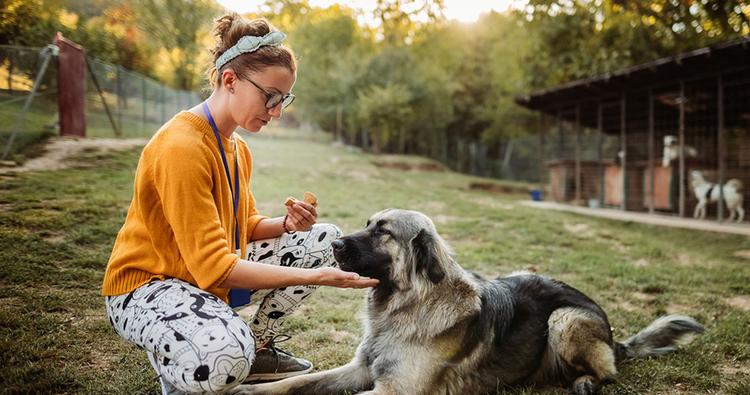Yes, You Can Train a Dog with Behavioral Issues
Some dogs just need a bit of training and encouragement to help them overcome undesired behaviors.
Some dogs just need a bit of training and encouragement to help them overcome undesired behaviors.
by Nisha Gopalan, | July 26, 2024

Photoboyko / iStock
You know those TikToks featuring doggie-personality glow-ups? Where a rescue shakes off their troubling behavior to show us the sweet little pup that’s been hiding inside all along? Cute factor aside, there is a lot we can learn from these videos.
First, no dog is perfect. Like humans, a canine’s personality is affected by their upbringing and environment. They are, at heart, resilient creatures who just want to be loved. This applies equally to purebreds, puppies, and rescues: No one dog is more likely to be less problematic than the other.
So, if you foster or adopt the doggie of your dreams and realize they’re not as perfect as they may have seemed, do not despair. Behind any undesirable behavior is an awesome creature waiting to be coaxed out of their emotional cage. Once that happens, you’ll learn that common dog behavior issues such as barking are, in fact, perfectly natural and not deal-breakers after all. With a bit of training, you’ll see that your dog, who’ll reward your gentle persistence with affection and loyalty, is kind of perfect in their imperfection after all.
Below, we break down some common dog behavioral issues alongside solutions that remind us to take a deep breath and remember that no problem is insurmountable.
No dog is inherently bad or broken. Each pup comes with a different backstory that can contribute to their behavior, be it genetic or through lived experiences. Your first objective should be to figure out what that backstory is and how it contributes to their behavior and reactions — be it fight, flight, or anything in between.
The good news? Dogs are very adaptable, so you’ll find that a little investment of your time and energy is worth the effort to get them on track to becoming your lifelong bestie. And if you need some help with that effort, reach out to the rescue where you adopted your dog (they’ll know a lot about their background) or a veterinarian (especially one who specializes in behavioral health).
It’s also worth noting that unrealistic expectations for our dog’s behavior can be an obstacle, too, so it’s important to adjust our own behaviors as pet parents.
Below are some common dog behavioral issues many pet parents face.
Certain behaviors, especially when they seemingly come out of nowhere, may be a sign that your pup is suffering from anything from a body ache or wound, to an allergy or GI issue, to a virus or infection. Visit your vet to rule out any illnesses if your dog suddenly exhibits any of the following:
Irritability
Antisocial behavior
Aggressiveness
Lethargy
Socialization is central to every dog’s emotional development. When a dog has been abused, neglected, abandoned, or simply undersocialized, they may not meet — and, therefore, learn how to interact healthily with — humans and other animals. One study by Australia’s La Trobe University states, ”Dogs that are appropriately socialized as puppies are less likely to exhibit behavioral problems as adults, including aggression and fearfulness.”
People tend to associate rescues with behavioral issues, but studies show that dogs who are raised in puppy mills (and then purchased online or in pet stores) may actually exhibit more psychological issues — such as fear, compulsive behavior, and increased sensitivity to being touched due to their troubling, confined upbringing.
The good news is that this can be corrected in dogs who are well past their puppy phase. Here are some signs that when exhibited towards humans or other dogs indicate your pup may require more socialization:
Fear (hiding, shaking, tucking their tails between their legs)
Reactivity (barking, lunging, jumping, being dominant)
Anxiety (frequently while being groomed)
Dogs, like any other living being, can be adversely affected by stress. In the case of rescue pups’ behavior issues, their reactions may be shaped by loud, disorienting, and scary shelter surroundings in which they’re often confined to small spaces. This, in turn, could lead to a wide array of survival behaviors, including:
Fear and anxiety (especially anti-social behavior)
Resource guarding (food or toys)
Reactivity (towards humans and other dogs)
Hyperactivity (including barking, jumping, and destructive behavior)
One study of shelters in New York State found that most puppies stay in shelters for 23 to 33 days, while adult dogs tended to wait for 42 days before they were adopted. If a dog is senior, a bully breed, has special needs, or is black in color (yes, you read that right), that wait can drag on even longer.
Anxiety is a pretty common source of dog behavioral issues, even for the most well-adjusted ones. Anything from fireworks to being left alone (because they’re not just your bestie; you’re theirs as well) can trigger this. Your pup may act out by:
Barking or whining
Pacing
Trembling
Urinating or having bowel movements indoors
According to the American Kennel Club, a dog’s genes may contribute to a pup’s behavioral tendencies. For instance, some breeds may be more inherently reserved, while others might more outwardly seek attention. Still, each dog is an individual, so any anticipated behavior simply isn’t a given.
How you train and socialize your dog ultimately shapes the way their behavior unfolds. Choosing a breed or mix associated with your ideal personality fit may make sense, but at the end of the day, a pet parent’s imperative to reward good behavior through positive-reinforcement techniques plays a significant role in how they act.
If you adopt, you’re already one step ahead because volunteers and staff who fostered or have spent significant time observing your pet can offer a wealth of insight into rescue dogs’ behavior issues. You’ll find them very helpful because they’re deeply committed to a fairy-tale ending: finding a pet parent who’s a good fit for the animal in need of a forever home. Additionally, many rescues and shelters offer free (or low-cost) behavioral training assistance to help you and your pup get off on the right foot.
However, if you buy your dog from a breeder, keep in mind that they’re running a for-profit business. They’ll know less about your dog and may not be so forthcoming in highlighting behavioral issues they may have noticed. And because they do not offer training assistance, you may be left to find help on your own.
When a pet parent believes that they can no longer care for their dog, they may surrender them to a rescue or animal shelter. This should be considered a last-ditch move since 3.1 million dogs enter shelters each year, which has led to an overcrowding crisis.
A person’s state of health or finances could motivate them to surrender or rehome their pet. But oftentimes, the root cause of relinquishment is frustration over a dog’s undesirable behavior by overwhelmed pet parents who don’t know how to adjust that behavior. But many of these behaviors can be addressed with a bit of time and patience. (Skip ahead for practical suggestions on how to help your dog.)
The reasons for relinquishing dogs are mostly due to:
Aggression (specifically, reactive or dominant behavior)
Excessive barking (especially caused by anxiety)
Destructive behaviors (often due to boredom or not meeting their needs)
It’s completely normal to be affected by your rescue dog’s behavioral issues. But it is not okay to react to that frustration or fatigue by yelling at them, smacking them, or banishing them to the backyard. Instead, calm yourself as you keep in mind that the behavior you don’t like can be successfully adjusted over time through positive-reinforcement training. You just need to stay the course to get results. Here are a few tips to get you into that headspace, alongside solutions to improve your dog’s behavior.
After you welcome a dog into your home, more likely than not, they won’t be the fantasy pup you dreamed of. This is because you’re introducing them to a new setting. They’ll need time to sniff around, adjust to a routine, and learn to trust you and their environment.
When in doubt, abide by the 3-3-3 rule. During this period, expect your dog to possibly be withdrawn, have indoor accidents, and express some fear. Meanwhile, your job is to patiently and proactively earn their trust as they acclimate. You can achieve this by letting them come to you, sweetly petting them when they ask you for attention, and giving out lots of treats to reinforce desirable behaviors.
Newsflash: Ignoring an ongoing behavioral issue will not make it go away. Thankfully, several effective strategies can help. Each should begin with (if possible) an attempt to eliminate or minimize whatever is triggering your rescue dog’s behavior issues.
Here are some helpful guides offering practical solutions to common dog behavior issues:
Too much barking: due to boredom, anxiety, and/or frustration
Fear: for dogs suddenly afraid of the outdoors
Stress: tips to calm your pup
Destructive behavior: when the chewing isn’t cute anymore
Separation anxiety: so your dog doesn’t have to panic when they’re alone
Attacking other dogs: teach them to play nice
Staring: so you can eat in peace
Creating change in your dog’s behavior is about balance. For instance, it’s completely normal for you to be sad and a little discouraged by your dog’s undesirable behavior. And it is fine to ignore your dog’s undesired behavior (as long as they won’t harm anyone else), but you must reward desired behavior. Positive reinforcement is key to success.
Your dog craves stability and consistency in their surroundings, and they will look to you for that. Positive reinforcement (petting them, giving them space, rewarding them with treats) will set the tone for this relationship. By showing your pup over time that you are their rock, they will trust you, listen to you, and follow your lead.
Change takes time. You’ve committed to raising this dog for their lifetime. One day you’ll look back, and these minor setbacks are going to seem like little bumps on an otherwise rewarding journey together.
In rarer cases, some dogs may require more intensive, regimented training. Just don’t give up on them. Dog behavior issues, such as resource guarding, can improve.
There are several organizations out there that can help. For instance, the Certification Council for Professional Dog Trainers touts its “humane” practices, and the Animal Behavior College emphasizes “positive reinforcement dog training techniques as their primary training tool.” You can also ask a local rescue for suggestions (or help), a veterinarian for a referral, or a friend who’s used a trainer they trust.
The important thing is to choose a properly certified “force free” trainer and vet them to make sure they use positive-reinforcement methods. Forceful, strict methods are ethically iffy at best and can instill even more fear-driven behaviors, which benefits neither you nor your beloved pup.
Adopting a “Problem Pet”: Behavior FAQs Answered
Behavior Counseling: Diagnosing a Behavior Problem
Prevalence of 25 Canine Behavioral Problems and Relevant Factors of Each
A Review of Medical Conditions and Behavioral Problems in Dogs and Cats

Nisha Gopalan has been a writer/editor for The New York Times, New York magazine, Entertainment Weekly, Variety, The Hollywood Reporter, and NYLON magazines. She currently resides in Los Angeles.

Adoption Advice

Behavior & Training

Behavior & Training

Behavior & Training

Behavior & Training


Breed Info
Are Pit Bulls dangerous? Uncover the truth behind stereotypes and myths surrounding these misunderstood dogs

Shelters & Rescue
Looking to adopt, but not sure which type of pet adoption organization is right for you? This guide is here to help.

Adoption Advice
Adopting a dog with a difficult past doesn’t have to be a deal-breaker. Here’s how you can help them thrive in their new home.

Adoption Advice
Learn what a rescue dog is and why these pups make the best buddies.

Adoption Advice

Behavior & Training